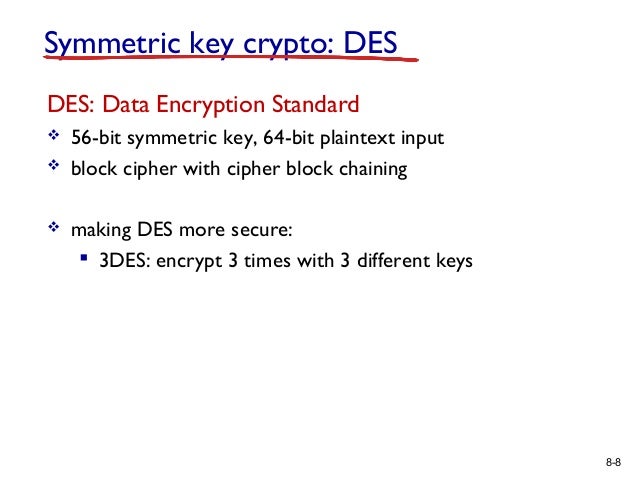Des Key Generation 56 Bits

∟Introduction to DES Algorithm
∟DES Key Schedule (Round Keys Generation) Algorithm
This section describes DES (Data Encryption Standard) algorithm - A 16-round Feistel cipher with block size of 64 bits.
Cyberghost vpn premium key generator 2015. Key schedule algorithm:
Jun 10, 2016 Another modified version of the DES algorithm is famously known as Triple DES. The key generator method creates 16 48-bit keys. The key generator method creates 16 48-bit keys. Note: This implementation of simplified data encryption standard in C programming language is compiled with GNU GCC compiler on Linux Ubuntu 14.04 operating system. The Data Encryption Standard (DES) is a symmetric-key block cipher published by the National Institute of Standards and Technology (NIST). DES is an implementation of a Feistel Cipher. It uses 16 round Feistel structure. The block size is 64-bit. Though, key length is 64-bit, DES has an effective key length of 56 bits. Key Generation. The round-key generator forms sixteen 48-bit keys out of a 56-bit cipher key in the cryptography. The process of key generation is depicted in the following steps, Initially key is of 64 bits. Then it goes under PI(1) and after that, it develops key of 56 bits; Then 56 bit of key divide into two half: left of 28 bit and right of 28 bit. DES input key size is 64 bit which contains 56 bit key and 8 parity bits. Parity bits are 8th bit of every 8 bits (on byte). So they are all multiple of eight:. Permuted choice PC-1 is used to remove these bits from the 64 bit input key. So PC-1 gives 56 bits as output. In round, there is a 56 bit input. A key size of 128 bits however this was reduced to 56 bits for DES. Even though DES actually accepts a 64 bit key as input, the remaining eight bits are used for parity checking and have no effect on DES’s security. Outsiders were convinced that the 56 bit key was an easy target for a brute force attack4 due to its extremely small size.
DES key schedule supporting tables:
Permuted Choice 1 - PC1:
Permuted Choice 2 - PC2:
Left shifts (number of bits to rotate) - r1, r2, .., r16:
Table of Contents
About This Book
Key Generation Software
Cryptography Terminology
Cryptography Basic Concepts
Introduction to AES (Advanced Encryption Standard)
►Introduction to DES Algorithm
What Is Block Cipher?
DES (Data Encryption Standard) Cipher Algorithm
►DES Key Schedule (Round Keys Generation) Algorithm
Key Generator
DES Decryption Algorithm
DES Algorithm - Illustrated with Java Programs
DES Algorithm Java Implementation
DES Algorithm - Java Implementation in JDK JCE
DES Encryption Operation Modes
DES in Stream Cipher Modes
PHP Implementation of DES - mcrypt
Blowfish - 8-Byte Block Cipher
Secret Key Generation and Management
Cipher - Secret Key Encryption and Decryption
Introduction of RSA Algorithm
RSA Implementation using java.math.BigInteger Class
Introduction of DSA (Digital Signature Algorithm)
Java Default Implementation of DSA
Private key and Public Key Pair Generation
PKCS#8/X.509 Private/Public Encoding Standards
Cipher - Public Key Encryption and Decryption
MD5 Mesasge Digest Algorithm
SHA1 Mesasge Digest Algorithm
OpenSSL Introduction and Installation
OpenSSL Generating and Managing RSA Keys
OpenSSL Managing Certificates
OpenSSL Generating and Signing CSR
OpenSSL Validating Certificate Path
'keytool' and 'keystore' from JDK
'OpenSSL' Signing CSR Generated by 'keytool'
Migrating Keys from 'keystore' to 'OpenSSL' Key Files
Certificate X.509 Standard and DER/PEM Formats
Migrating Keys from 'OpenSSL' Key Files to 'keystore'
Using Certificates in IE
Using Certificates in Google Chrome
Using Certificates in Firefox
Outdated Tutorials
References
Full Version in PDF/EPUB